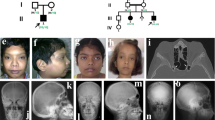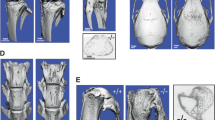Abstract
We studied ten individuals from eight families showing features consistent with the immuno-osseous dysplasia spondyloenchondrodysplasia. Of particular note was the diverse spectrum of autoimmune phenotypes observed in these individuals (cases), including systemic lupus erythematosus, Sjögren's syndrome, hemolytic anemia, thrombocytopenia, hypothyroidism, inflammatory myositis, Raynaud's disease and vitiligo. Haplotype data indicated the disease gene to be on chromosome 19p13, and linkage analysis yielded a combined multipoint log10 odds (LOD) score of 3.6. Sequencing of ACP5, encoding tartrate-resistant acid phosphatase, identified biallelic mutations in each of the cases studied, and in vivo testing confirmed a loss of expressed protein. All eight cases assayed showed elevated serum interferon alpha activity, and gene expression profiling in whole blood defined a type I interferon signature. Our findings reveal a previously unrecognized link between tartrate-resistant acid phosphatase activity and interferon metabolism and highlight the importance of type I interferon in the genesis of autoimmunity.
This is a preview of subscription content, access via your institution
Access options
Subscribe to this journal
Receive 12 print issues and online access
$209.00 per year
only $17.42 per issue
Buy this article
- Purchase on Springer Link
- Instant access to full article PDF
Prices may be subject to local taxes which are calculated during checkout





Similar content being viewed by others
Accession codes
References
Schorr, S., Legum, C. & Ochshorn, M. Spondyloenchondrodysplasia - enchondromatosis with severe platyspondyly in 2 brothers. Radiology 118, 133–139 (1976).
Renella, R. et al. Spondyloenchondrodysplasia with spasticity, cerebral calcifications, and immune dysregulation: Clinical and radiographic delineation of a pleiotropic disorder. Am. J. Med. Genet. A. 140A, 541–550 (2006).
Navarro, V. et al. Two further cases of spondyloenchondrodysplasia (SPENCD) with immune dysregulation. Am. J. Med. Genet. A. 146A, 2810–2815 (2008).
Tan, E.M. et al. The 1982 revised criteria for the classification of Systemic Lupus Erythematosus. Arthritis Rheum. 25, 1271–1277 (1982).
Raymond, A.A., Zariah, A.A., Samad, S.A., Chin, C.N. & Kong, N.C. Brain calcification in patients with cerebral lupus. Lupus 5, 123–128 (1996).
Hayman, A.R. et al. Mice lacking tartrate-resistant acid phosphatase (Acp 5) have disrupted endochondral ossification and mild osteopetrosis. Development 122, 3151–3162 (1996).
Bune, A.J., Hayman, A.R., Evans, M.J. & Cox, T.M. Mice lacking tartrate-resistant acid phosphatase (Acp 5) have disordered macrophage inflammatory responses and reduced clearance of the pathogen, Staphylococcus aureus. Immunology 102, 103–113 (2001).
Crow, M.K. Type I interferon in systemic lupus erythematosus. Curr. Top. Microbiol. Immunol. 316, 359–386 (2007).
Crow, Y.J. & Livingston, J.H. Aicardi-goutieres syndrome: an important Mendelian mimic of congenital infection. Dev. Med. Child Neurol. 50, 410–416 (2008).
Baechler, E.C. et al. Interferon-inducible gene expression signature in peripheral blood cells of patients with severe lupus. Proc. Natl. Acad. Sci. USA 100, 2610–2615 (2003).
Hayman, A.R., Macary, P., Lehner, P.J. & Cox, T.M. Tartrate-resistant acid phosphatase (Acp 5): identification in diverse human tissues and dendritic cells. J. Histochem. Cytochem. 49, 675–684 (2001).
Muhonen, P. et al. Sequence and TLR9 independent increase of TRACP expression by antisense DNA and siRNA molecules. Biochem. Biophys. Res. Commun. 359, 889–895 (2007).
Suter, A. et al. Overlapping functions of lysosomal acid phosphatase (LAP) and tartrate-resistant acid phosphatase (Acp5) revealed by doubly deficient mice. Development 128, 4899–4910 (2001).
Kariuki, S.N. et al. Age- and gender-specific modulation of serum osteopontin and interferon-alpha by osteopontin genotype in systemic lupus erythematosus. Genes Immun. 10, 487–494 (2009).
Shinohara, M.L. et al. Osteopontin expression is essential for interferon-alpha production by plasmacytoid dendritic cells. Nat. Immunol. 7, 498–506 (2006).
Weber, G.F. et al. Phosphorylation-dependent interaction of osteopontin with its receptors regulates macrophage migration and activation. J. Leukoc. Biol. 72, 752–761 (2002).
Botto, M. et al. Complement in human diseases: lessons from complement deficiencies. Mol. Immunol. 46, 2774–2783 (2009).
Lee-Kirsch, M.A. et al. Mutations in the gene encoding the 3′-5′ DNA exonuclease TREX1 are associated with systemic lupus erythematosus. Nat. Genet. 39, 1065–1067 (2007).
Stetson, D.B., Ko, J.S., Heidmann, T. & Medzhitov, R. Trex1 prevents cell-intrinsic initiation of autoimmunity. Cell 134, 587–598 (2008).
Lood, C. et al. C1q inhibits immune complex-induced interferon-alpha production in plasmacytoid dendritic cells: a novel link between C1q deficiency and systemic lupus erythematosus pathogenesis. Arthritis Rheum. 60, 3081–3090 (2009).
Santer, D.M. et al. C1q deficiency leads to the defective suppression of IFN-α in response to nucleoprotein containing immune complexes. J. Immunol. 185, 4738–4749 (2010).
Sträter, N. et al. Crystal structures of recombinant human purple Acid phosphatase with and without an inhibitory conformation of the repression loop. J. Mol. Biol. 351, 233–246 (2005).
Campos-Xavier, A.B. et al. Mutations in the heparan-sulfate proteoglycan glypican 6 (GPC6) impair endochondral ossification and cause recessive omodysplasia. Am. J. Hum. Genet. 84, 760–770 (2009).
Chao, T.Y. et al. Development of immunoassays for serum tartrate-resistant acid phosphatase isofrom 5a. Clin. Chim. Acta 359, 132–140 (2005).
Janckila, A.J., Neustadt, D.H. & Yam, L.T. Significance of serum TRAP in rheumatoid arthritis. J. Bone Miner. Res. 23, 1287–1295 (2008).
Ankel, H., Westra, D.F., Welling-Wester, S. & Lebon, P. Induction of interferon-alpha by glycoprotein D of herpes simplex virus: a possible role of chemokine receptors. Virology 251, 317–326 (1998).
Jabs, W.J., Henning, C., Zawatzky, R. & Kirchner, H. Failure to detect antiviral activity in serum and plasma of healthy individuals displaying high activity in ELISA for IFN-alpha and IFN-beta. J. Interferon Cytokine Res. 19, 463–469 (1999).
Dubos, F. et al. Interferon alpha production in the serum of very young infants after viral infections. Med. Mal. Infect. 34, 561–565 (2004).
Storey, J.D. & Tibshirani, R. Statistical significance for genomewide studies. Proc. Natl. Acad. Sci. USA 100, 9440–9445 (2003).
Word, J.M., Lovell, S.C., Richardson, J.S. & Richardson, D.C. Asparagine and glutamine: using hydrogen atom contacts in the choice of side-chain amide orientation. J. Mol. Biol. 285, 1735–1747 (1999).
Word, J.M. et al. Visualizing and quantifying molecular goodness-of-fit: small-probe contact dots with explicit hydrogen atoms. J. Mol. Biol. 285, 1711–1733 (1999).
Chen, V.B., Davis, I.W. & Richardson, D.C. KiNG (Kinemage, Next Generation): a versatile interactive molecular and scientific visualization program. Protein Sci. 18, 2403–2409 (2009).
Lovell, S.C., Word, J.M., Richardson, J.S. & Richardson, D.C. The penultimate rotamer library. Proteins 40, 389–408 (2000).
Acknowledgements
We would like to thank the families for their cooperation in the research presented here; B. Eguia, AP-HP, Department of Dermatology and Allergy, Hôpital Tenon, Paris, France for providing medical images; B. Smith for technical support; and D. Bonthron for insightful comments on the manuscript. We wish to acknowledge L. Wardleworth and A. Hayes from the Microarray Facility, Faculty of Life Sciences, University of Manchester, Manchester, UK. T.A.B. is supported as a Wellcome Trust Clinical Fellow. Y.J.C., J.U. and S.D. acknowledge the Manchester National Institute for Health Research Biomedical Research Centre. The research leading to these results has received funding from the European Union's Seventh Framework Programme (FP7/2007-2013) under grant agreement number 241779.
Author information
Authors and Affiliations
Contributions
S.D., J.U. and T.A.B. performed SNP genotyping. T.A.B. performed sequencing with contributions from S.D., H.G., G.I.R. and M.S. QMPSF analysis was undertaken by J.U. and M.S. Interferon assays were conducted by P.L. L.A.H.Z. performed microarray analysis. RT-PCR and qPCR was conducted by G.I.R., T.A.B., H.G., E.H. and E.S.F. Protein assays were preformed by A.J. for TRAP and by N.S. for OPN. ACP5 expression in different human cell types was assessed by K.B.E. and A.W. Lymphocyte subset analysis was conducted by C.P., A.P. and F.R.-L. Bioinformatics analysis was conducted by S.C.L. All other coauthors identified subjects with SPENCD and performed related clinical and laboratory studies (B.B.-M., K.B., S.B., V.B., M.W.B., F.d.Z., C.F., C.J.-D., M.L.K., M.L.M., A.L., K.M., L.M., V.N., C.M.R., S.S.-B. and C.W.). G.I.R., J.-L.C., A.R.H., R.J.D. and G.C.M.B. provided critical input into project development and manuscript preparation. Y.J.C. designed and supervised the project and wrote the manuscript.
Corresponding author
Ethics declarations
Competing interests
The authors declare no competing financial interests.
Supplementary information
Supplementary Text and Figures
Supplementary Note, Supplementary Figures 1–4 and Supplementary Tables 1–7 (PDF 488 kb)
Rights and permissions
About this article
Cite this article
Briggs, T., Rice, G., Daly, S. et al. Tartrate-resistant acid phosphatase deficiency causes a bone dysplasia with autoimmunity and a type I interferon expression signature. Nat Genet 43, 127–131 (2011). https://doi.org/10.1038/ng.748
Received:
Accepted:
Published:
Issue Date:
DOI: https://doi.org/10.1038/ng.748
This article is cited by
-
Spondyloenchondrodysplasia in five new patients: identification of three novel ACP5 variants with variable neurological presentations
Molecular Genetics and Genomics (2023)
-
JAKs and STATs from a Clinical Perspective: Loss-of-Function Mutations, Gain-of-Function Mutations, and Their Multidimensional Consequences
Journal of Clinical Immunology (2023)
-
The type I interferonopathies: 10 years on
Nature Reviews Immunology (2022)
-
Association of rare variants in genes of immune regulation with pediatric autoimmune CNS diseases
Journal of Neurology (2022)
-
Autoinflammation – Eine klinische und genetische Herausforderung
Der Hautarzt (2022)



